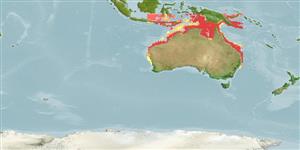>
Carangaria/misc (Various families in series Carangaria) >
Polynemidae (Threadfins)
Etymology: Polydactylus: Greek, poly = a lot of + greek, daktylos = finger (Ref. 45335).
More on author: Günther.
Environment: milieu / climate zone / depth range / distribution range
Ecología
marino; salobre demersal; rango de profundidad 10 - 56 m (Ref. 45356), usually 10 - 56 m (Ref. 45356). Tropical; 4°S - 34°S, 113°E - 154°E (Ref. 57343)
Distribución
Países | Áreas FAO | Ecosistemas | Ocurrencias, apariciones | Point map | Introducciones | Faunafri
Eastern Indian Ocean and Western Pacific: known only from southern Indonesia (Timor and Arafura seas) and northern Australia (Exmouth Gulf, Western Australia to Clarence River, New South Wales) (Ref. 9685). The type locality (China) may most likely be erroneous.
Tamaño / Peso / Age
Maturity: Lm ? range ? - ? cm
Max length : 21.0 cm FL macho / no sexado; (Ref. 1844); 24.5 cm FL (female)
Inhabits coastal waters over sand or mud bottoms. Feeds on prawns. Often taken in association with Penaeus prawns in the Gulf of Carpentaria.
Life cycle and mating behavior
Madurez | Reproducción | Puesta | Huevos | Fecundidad | Larva
Sex change occurs between 12-14 cm SL (Ref. 45356).
Motomura, H., 2004. Threadfins of the world (Family Polynemidae). An annotated and illustrated catalogue of polynemid species known to date. FAO Spec. Cat. Fish. Purp. Rome: FAO. 3:117 p. (Ref. 57343)
IUCN Red List Status (Ref. 130435: Version 2024-1)
Threat to humans
Harmless
Human uses
Pesquerías: sin interés
Herramientas
Special reports
Download XML
Fuentes de Internet
Estimates based on models
Preferred temperature (Ref.
123201): 25.4 - 28.7, mean 27.7 °C (based on 632 cells).
Phylogenetic diversity index (Ref.
82804): PD
50 = 0.5000 [Uniqueness, from 0.5 = low to 2.0 = high].
Bayesian length-weight: a=0.00794 (0.00468 - 0.01347), b=3.12 (2.97 - 3.27), in cm total length, based on LWR estimates for this species & Genus-body shape (Ref.
93245).
Nivel trófico (Ref.
69278): 3.1 ±0.30 se; based on food items.
Resiliencia (Ref.
120179): Medio, población duplicada en un tiempo mínimo de 1.4-4.4 años (K=0.16).
Fishing Vulnerability (Ref.
59153): Low vulnerability (17 of 100).
